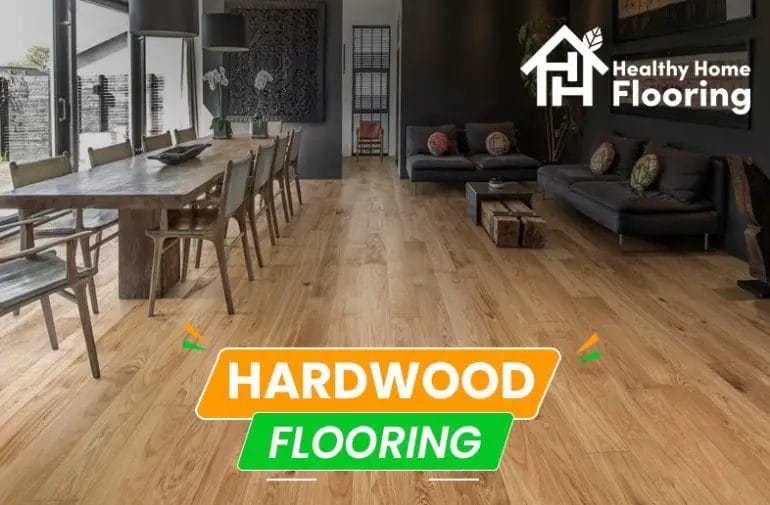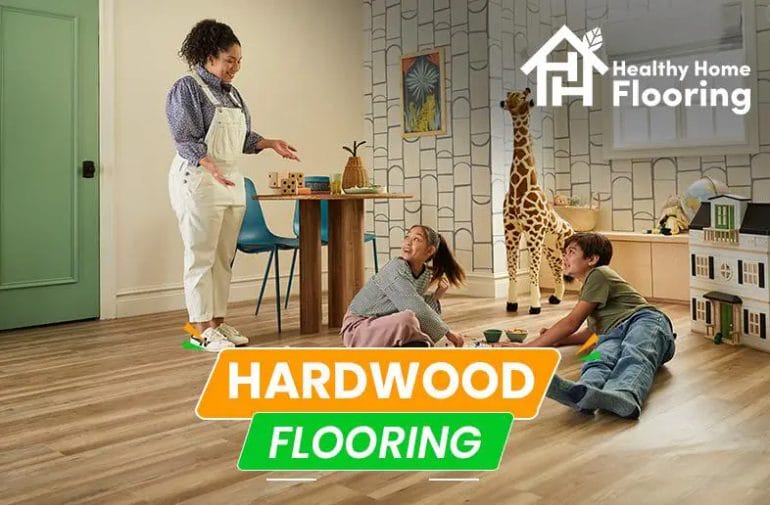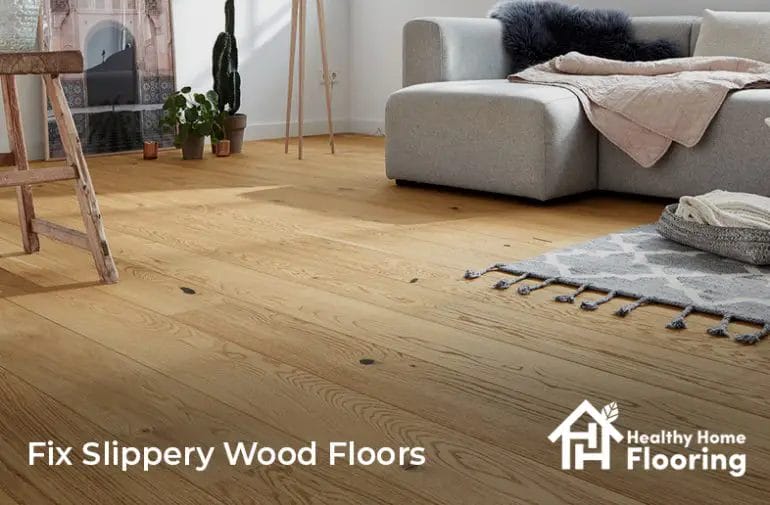If you’re dealing with slippery wood floors, you know how dangerous and frustrating it can be. But don’t worry, there are effective ways to fix this issue. One solution is to apply an anti-slip coating or finish to the surface of the floor. This will provide traction and reduce the risk of slipping. Another option is to use non-slip rugs or mats in high traffic areas. Additionally, you can try using anti-slip adhesive strips or pads on the bottom of furniture to prevent it from sliding.
Regular cleaning is also important to maintain the grip of your wood floors. Make sure to use a cleaner specifically designed for wood floors, as some cleaning products can leave behind a slippery residue. Lastly, consider using a wood floor wax or polish that enhances traction and improves the overall grip of the surface. With these simple steps, you can restore the safety and stability of your slippery wood floors.


Choosing the right non-slip flooring solutions
When it comes to selecting non-slip flooring solutions for your home or business, there are several factors to consider. Non-slip flooring is essential in areas where the risk of slipping and falling is high, such as bathroom floors, kitchen floors, and outdoor spaces. By choosing the right non-slip flooring, you can enhance safety and prevent accidents. Here are some important factors to keep in mind when selecting non-slip flooring solutions:
1. Material
The material of the flooring plays a crucial role in its slip resistance. Different materials have different levels of traction and slip resistance. Some common non-slip flooring materials include rubber, vinyl, and epoxy. Rubber flooring is a popular choice for areas prone to spills and moisture, as it offers excellent slip resistance even when wet. Vinyl flooring is known for its durability and slip-resistant properties. Epoxy flooring, on the other hand, provides a seamless and non-slip surface that is easy to clean and maintain.
2. Texture
The texture of the flooring also plays a significant role in slip resistance. Textured surfaces offer better traction and grip, reducing the chances of slipping. Look for flooring options with a textured or embossed surface that provides a good grip underfoot. Avoid smooth and glossy surfaces, as they can become slippery, especially when wet.
3. Slip Resistance Rating
Slip resistance ratings measure the coefficient of friction of a flooring surface. The higher the slip resistance rating, the better the traction of the flooring. Look for flooring products that have been tested and certified for slip resistance. These ratings are typically provided by manufacturers and can help you make an informed decision.
4. Cleaning and Maintenance
Consider the cleaning and maintenance requirements of the non-slip flooring solutions. Some flooring materials and textures may require more frequent cleaning and maintenance to preserve their slip-resistant properties. Choose flooring options that are easy to clean and maintain in your specific environment.
5. Aesthetics
While safety is paramount, aesthetics also play a role in the selection of non-slip flooring solutions. Look for options that complement the overall design and style of your space. Many non-slip flooring options are available in a variety of colors, patterns, and finishes, allowing you to find a visually appealing solution that meets your safety needs.
6. Professional Installation
Proper installation is crucial to ensuring the effectiveness of non-slip flooring solutions. It is recommended to hire a professional flooring installer who is experienced in working with non-slip materials. They will ensure that the flooring is installed correctly and securely, maximizing its slip resistance and longevity.
In summary, choosing the right non-slip flooring solutions involves considering the material, texture, slip resistance rating, cleaning and maintenance requirements, aesthetics, and professional installation. By taking these factors into account, you can select non-slip flooring options that enhance safety and minimize the risk of slips and falls in your home or business.

DIY Tips for Making Wood Floors Less Slippery
Wood floors can provide a beautiful and timeless look to any home. However, one downside of wood floors is that they can sometimes be slippery, posing a risk of accidents and falls. If you’re looking for ways to make your wood floors less slippery, here are some DIY tips that can help:1. Clean the Floors Regularly
One of the simplest and most effective ways to reduce slipperiness on wood floors is to keep them clean. Dust, dirt, and grime can build up over time, making the surface more slippery. Regularly sweeping or vacuuming the floors will help remove any loose debris and minimize the risk of slipping.2. Use Rugs or Mats
Adding rugs or mats to high-traffic areas can provide extra traction and reduce the slipperiness of wood floors. Look for non-slip rug pads or mats that have a rubberized backing to ensure they stay securely in place. Place them in areas such as entryways, hallways, or near the kitchen sink where water or spills are more likely to occur.3. Apply Anti-Slip Coating
An effective way to make wood floors less slippery is to apply an anti-slip coating. There are various products available in the market specifically designed for this purpose. These coatings create a textured surface on the wood, providing better traction and reducing the risk of slipping. Make sure to follow the manufacturer’s instructions when applying the coating for optimal results.4. Add Traction with Tread Strips
Tread strips are a practical solution for improving the grip on wood floors. These adhesive strips are designed to provide extra traction and can be easily applied to the surface of the wood. They come in various sizes and colors, allowing you to choose the ones that best match your decor. Tread strips are particularly useful on stairs or in areas where slipping is more common.5. Sand the Wood Surface
Sanding the wood surface can help reduce slipperiness by creating a slightly rougher texture. This can be done by gently sanding the surface of the floorboards using sandpaper or a sanding machine. Be careful not to sand too aggressively as this can damage the wood. After sanding, make sure to clean the floors thoroughly to remove any dust or debris.6. Use Non-Slip Floor Wax
Non-slip floor wax is another option for making wood floors less slippery. This type of wax contains additives that provide extra traction and grip. Apply the wax according to the manufacturer’s instructions, ensuring that the floors are clean and dry beforehand. Regular reapplication may be necessary depending on the level of foot traffic in the area.7. Consider Changing Footwear
Sometimes the problem of slippery wood floors can be exacerbated by the type of footwear being worn. High heels or shoes with smooth soles can increase the risk of slipping. Consider wearing shoes with rubber soles or adding non-slip sole attachments to your shoes to improve traction and stability on wood floors. In summary, making wood floors less slippery can be achieved through various DIY methods. Regular cleaning, using rugs or mats, applying anti-slip coating, adding tread strips, sanding the wood surface, using non-slip floor wax, and considering footwear options can all contribute to improving the traction and safety of your wood floors. By implementing these DIY tips, you can enjoy the beauty of your wood floors without worrying about slips or falls.
Professional Services for Fixing Slippery Wood Floors
If you have hardwood floors in your home or business, you may have encountered the issue of slippery surfaces. Whether it’s due to the material used, wear and tear, or improper cleaning, slippery wood floors can pose a safety risk and be a cause for concern. Fortunately, there are professional services available that specialize in fixing this problem and ensuring your wood floors are safe and slip-resistant.
1. Floor Sanding and Refinishing
One common solution for slippery wood floors is floor sanding and refinishing. This process involves removing the existing finish and applying a new one to restore the floor’s traction and reduce slipperiness. Professional floor sanding companies have the expertise and equipment to carefully sand the surface, removing any imperfections, scratches, or worn-out coatings that could contribute to the slipperiness. They then apply a high-quality finish that enhances the grip and provides a more secure walking surface.
2. Non-Slip Coatings
Another effective way to address slippery wood floors is by applying non-slip coatings. These coatings are designed to increase the friction between your feet and the floor, making it less likely for slips and falls to occur. Professional service providers can assess the condition of your wood floors and recommend the most suitable non-slip coating for your specific needs. They will apply the coating evenly and ensure it adheres properly to the surface, providing you with long-lasting slip resistance.
3. Anti-Slip Treatments
Anti-slip treatments are another option to consider for fixing slippery wood floors. These treatments involve applying a chemical solution to the surface of the floor, which creates a microscopic texture that improves traction and reduces the risk of slipping. Professional service providers have access to specialized anti-slip treatments that are safe for use on hardwood floors. They will apply the treatment evenly and according to the manufacturer’s instructions, ensuring optimal performance and durability.
4. Floor Cleaning and Maintenance
Proper floor cleaning and maintenance play a crucial role in preventing slippery wood floors. Professional cleaning services can deep clean your hardwood floors, removing any dirt, grime, or residue that could contribute to the slipperiness. They will use appropriate cleaning products and techniques that are safe for wood surfaces and won’t compromise the finish or traction. Regular maintenance, such as sweeping and mopping with non-slip floor cleaners, can also help maintain the slip resistance of your wood floors.
5. Consultation and Inspection
Before deciding on the best solution for fixing your slippery wood floors, it’s essential to consult with professionals who specialize in wood floor care. They will assess the condition of your floors, identify the root cause of the slipperiness, and recommend the most appropriate course of action. This initial consultation and inspection allow you to make an informed decision and ensure that the chosen service effectively addresses your specific issue.
In summary, if you have slippery wood floors, it’s crucial to seek the assistance of professional services that specialize in fixing this problem. Whether through floor sanding and refinishing, non-slip coatings, anti-slip treatments, or proper cleaning and maintenance, these professionals can help restore the slip resistance of your wood floors, making them safe and secure for everyone in your home or business.
Best practices for maintaining safe wood flooring
Wood flooring is a popular choice for many homeowners due to its durability, warmth, and timeless appeal. However, like any other type of flooring, wood floors require regular maintenance to ensure their safety and longevity. In this section, we will discuss some best practices for maintaining safe wood flooring.
1. Regular cleaning
One of the most important steps in maintaining safe wood flooring is regular cleaning. This helps to remove dirt, dust, and debris that can scratch the surface of the wood or cause it to become slippery. Use a soft-bristled broom or vacuum with a brush attachment to sweep the floor on a daily basis. Avoid using harsh chemicals or abrasive cleaners, as they can damage the wood finish.
2. Preventing water damage
Wood flooring is susceptible to water damage, which can cause the wood to warp, swell, or even develop mold and mildew. To prevent water damage, clean up spills immediately using a dry cloth or paper towel. Avoid using excessive water when mopping the floor and ensure it is completely dry afterwards. Place mats or rugs in high-traffic areas or near entryways to trap moisture and prevent it from reaching the wood.
3. Avoiding scratches and dents
Preventing scratches and dents is essential for maintaining the safety and appearance of wood flooring. Place furniture pads or felt protectors under the legs of chairs, tables, and other heavy furniture to prevent them from scratching the floor. Avoid dragging heavy objects across the floor, as this can cause deep scratches. If necessary, use a protective mat or area rug in areas where heavy items are frequently moved.
4. Regular maintenance
In addition to regular cleaning, wood floors require periodic maintenance to keep them in good condition. This may include refinishing or resealing the wood to protect it from wear and tear. Consult with a professional or refer to the manufacturer’s guidelines for the recommended maintenance schedule for your specific type of wood flooring.
5. Temperature and humidity control
Wood flooring is sensitive to changes in temperature and humidity, which can cause it to expand or contract. Maintain a consistent indoor temperature and humidity level to prevent damage to the wood. Use a humidifier during dry seasons to add moisture to the air, and use a dehumidifier during humid seasons to reduce excess moisture. Avoid extreme temperature changes, such as sudden blasts of hot or cold air, as this can also lead to wood floor damage.
6. Regular inspections
Regularly inspect your wood flooring for any signs of damage, such as cracks, gaps, or loose boards. Address these issues promptly to prevent further damage and ensure the safety of the floor. If you notice any significant damage or concerns, it is recommended to consult with a professional for proper repair or replacement.
7. Educate household members
Lastly, educate all household members about the proper care and maintenance of wood flooring. Teach them to remove their shoes before walking on the wood floor, as small rocks or debris on the soles can cause scratches. Encourage the use of floor mats or rugs in high-traffic areas to protect the wood. By promoting proper care and awareness, you can maintain a safe and beautiful wood floor for years to come.
In summary, maintaining safe wood flooring requires regular cleaning, preventing water damage, avoiding scratches and dents, performing regular maintenance, controlling temperature and humidity, conducting regular inspections, and educating household members on proper care. By following these best practices, you can keep your wood flooring in optimal condition and create a safe environment for your home.
FAQs
Q: How can I fix slippery wood floors?
To fix slippery wood floors, you can try a few solutions. First, clean the floors thoroughly to remove any residue or dirt that may be causing the slipperiness. Additionally, you can apply an anti-slip coating or add non-slip pads or rugs to high traffic areas. Another option is to use a traction-enhancing product specifically designed for wood floors.
Q: Are there any natural remedies to make wood floors less slippery?
Yes, there are natural remedies to make wood floors less slippery. One option is to mix equal parts vinegar and water, and use it to mop the floors. Vinegar helps to remove any residue that might be making the floors slippery. Another natural method is to sprinkle baking soda on the floor, let it sit for a few minutes, and then wipe it away with a damp cloth.
Q: Can adding rugs or mats help with slippery wood floors?
Yes, adding rugs or mats can help with slippery wood floors. Place non-slip rugs or mats in high traffic areas or areas prone to moisture, such as entryways or kitchens. Make sure to choose rugs or mats with a non-slip backing or use rug pads to prevent them from slipping. This can provide added traction and reduce the risk of slips and falls.
Conclusion
In conclusion, fixing slippery wood floors can be a relatively simple task with the right approach. By implementing some preventive measures, such as using non-slip rugs or applying anti-slip coatings, you can significantly reduce the risk of slipping and falling. Additionally, regular cleaning and maintenance of your wood floors, including removing any excess moisture or debris, can help improve traction and make them less slippery. If the problem persists, it might be worth considering professional assistance to assess the underlying causes and provide a long-term solution. Remember, ensuring the safety of your floors not only prevents accidents but also enhances the overall aesthetic appeal of your home.